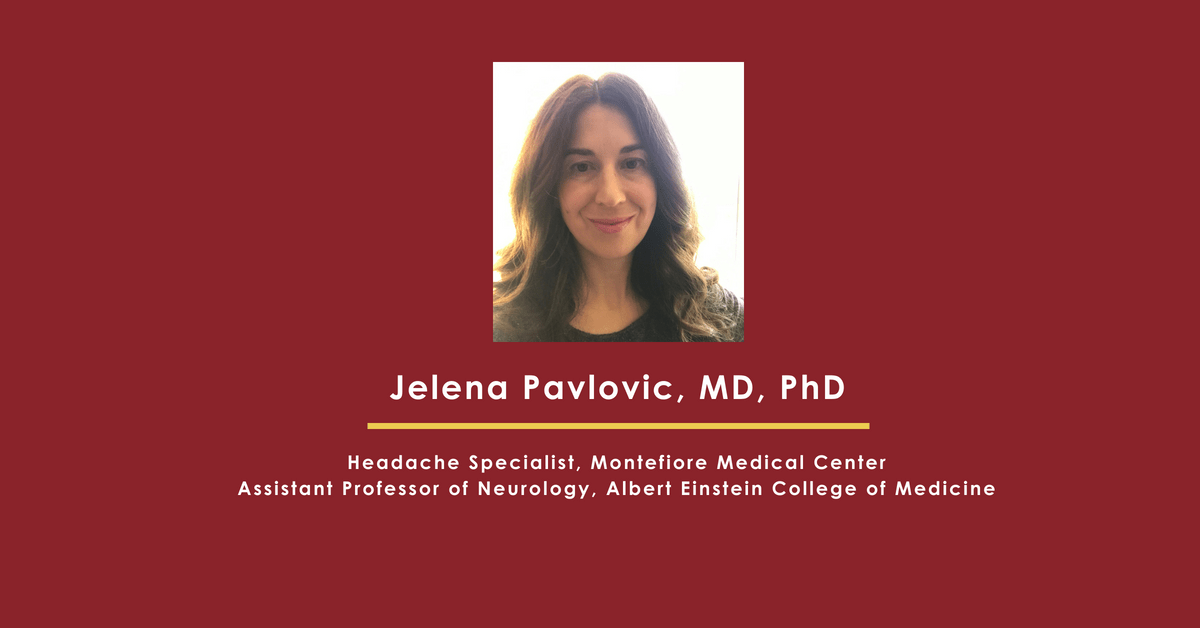
In Their Words: AHS Member Jelena Pavlovic, MD, PhD, Shares Her Migraine Story
Jelena Pavlovic, MD, PhD, speaks on her personal history with migraine and the importance of listening to patients’ symptoms.
Headache Specialist at Montefiore Medical Center and Assistant Professor of Neurology at Albert Einstein College of Medicine, Jelena Pavlovic, MD, PhD, has been living with migraine since childhood. This experience, she says, gives her a deeper understanding of how her patients deal with migraine attacks, and enables her to practice what she preaches. She recently spoke with the American Headache Society about how living with migraine has impacted her life, and the importance of listening to every patient’s story in order to formulate the treatment plan that is not only diagnosis but person specific.
Can you tell us about your personal experience with migraine?
I was 11 years old when I experienced my first migraine. That experience is still very vivid as I think it often is for many people with migraine. I remember it clearly because it started with an aura, which was simultaneously fascinating and scary. Once the pain started, I remember being nauseous and sick and spending the rest of the day in bed. My migraine attacks were relatively rare in the first few years, but the individual attacks were pronounced and quite debilitating. I remember hurting so much and a feeling of loss for missing out on my activities.
Like many people with migraine, I come from a family with a history of migraine across several generations. This helped in the sense that I was familiar with the symptoms and at least not asking “what is happening to me?” I was familiar with the symptoms and with the need to go and lie down in a dark and quiet room. So in a way, the familial burden of migraine also came with familial support of my father, a physician, and his sisters offering migraine treatment tips early on. The first time I saw a physician specifically for headache, I was a headache fellow at the Montefiore Headache Center. I wish I sought help earlier, but it does illustrate the common scenario of patients often seeking help for their headaches after years and sometimes decades of symptoms.
How has your relationship with migraine changed?
Having migraine has certainly impacted some of my life’s choices, if not directly than indirectly in some form. For example, I loved organic chemistry in college, but realized that certain chemicals in the lab would give me really bad headaches. I realized that pursuing further work in chemistry would not be possible. That said, having a good understanding of my headache triggers has brought a dose of confidence that comes in overall management of migraine. It can be very hard to burden oneself with trigger avoidance, so I do not commonly avoid my triggers, but I do have to manage them. What I mean by that is that I have my own system of how I conceptualize my triggers. So, for example, I will not go on a rollercoaster because that is a trigger that is easy to avoid. I will avoid the perfume section of a department store, but I will not avoid events. If I know that I may not have a chance to take it easy during the event—a recent trip to the water park with my children comes to mind—I will pre-treat so I can function optimally the whole time. I am fortunate in the sense that my headaches are responsive to treatment most of the time—which, I know, is not the case for everyone.
How has living with migraine affected your approach to patient care?
The fact that I have migraine translates to how I practice migraine and headache diagnosis and treatment. I’m open about my personal experiences with migraine with my patients so that they know where I’m coming from. Most patients seem to find it reassuring. From a very practical point of view, I know the nitty-gritty of things like how difficult the large tablets are to swallow and how challenging some packaging may be to open, particularly in the midst of a migraine. I’m able to give tips on how to manage headaches and live with migraine that one just doesn’t learn in medical school or residency.
What should medical professionals outside of headache medicine know about people living with migraine and other headache disorders?
Believing the patient is number one. But it’s not the patient’s responsibility to present a coherent story that makes immediate sense to the medical professional. Physicians need to listen to their patients’ stories and take them at face value. Given the time limitations of a typical health visit, this can often be much harder to do than it seems. For example, doctors in the emergency room tend to see people at their worst. The patient may not be able to fully or most accurately describe their symptoms in such a setting. This is where the art of listening comes in.
That said, patients who experience symptoms consistent with textbook migraine will be easy to diagnose. But a lot of patients with migraine might not have the classic symptoms. Someone with sensitivity to light may wear sunglasses indoors all the time, and it becomes a way of life for patients who are not getting appropriate treatment. They might not be able to decipher their symptoms anymore, since they’ve learned to live with them. They might not be able to give the kind of narrative that will inform the clinician taking care of them. But that doesn’t mean their narrative is not correct or that there aren’t alternative narratives out there. Not all migraine stories fit neatly into the diagnosis taught in medical school, but asking open-ended questions and gently guiding a patient in need will most often lead to the right diagnoses and, therefore, allow for appropriate treatment.


